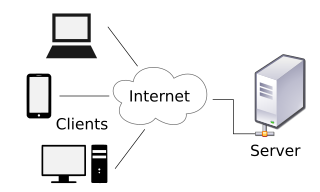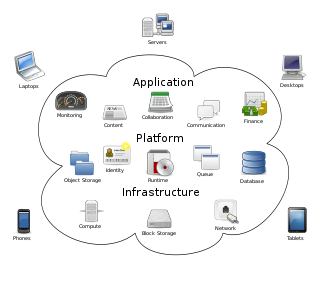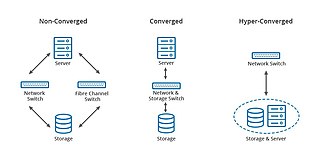
The client–server model is a distributed application structure that partitions tasks or workloads between the providers of a resource or service, called servers, and service requesters, called clients. Often clients and servers communicate over a computer network on separate hardware, but both client and server may reside in the same system. A server host runs one or more server programs, which share their resources with clients. A client usually does not share any of its resources, but it requests content or service from a server. Clients, therefore, initiate communication sessions with servers, which await incoming requests. Examples of computer applications that use the client–server model are email, network printing, and the World Wide Web.
In computing, virtualization or virtualisation is the act of creating a virtual version of something at the same abstraction level, including virtual computer hardware platforms, storage devices, and computer network resources.

Cloud computing is the on-demand availability of computer system resources, especially data storage and computing power, without direct active management by the user. Large clouds often have functions distributed over multiple locations, each of which is a data center. Cloud computing relies on sharing of resources to achieve coherence and typically uses a pay-as-you-go model, which can help in reducing capital expenses but may also lead to unexpected operating expenses for users.
Dynamic Infrastructure is an information technology concept related to the design of data centers, whereby the underlying hardware and software can respond dynamically and more efficiently to changing levels of demand. In other words, data center assets such as storage and processing power can be provisioned to meet surges in user's needs. The concept has also been referred to as Infrastructure 2.0 and Next Generation Data Center.
Eucalyptus is a paid and open-source computer software for building Amazon Web Services (AWS)-compatible private and hybrid cloud computing environments, originally developed by the company Eucalyptus Systems. Eucalyptus is an acronym for Elastic Utility Computing Architecture for Linking Your Programs To Useful Systems. Eucalyptus enables pooling compute, storage, and network resources that can be dynamically scaled up or down as application workloads change. Mårten Mickos was the CEO of Eucalyptus. In September 2014, Eucalyptus was acquired by Hewlett-Packard and then maintained by DXC Technology. After DXC stopped developing the product in late 2017, AppScale Systems forked the code and started supporting Eucalyptus customers.
In computer science, memory virtualization decouples volatile random access memory (RAM) resources from individual systems in the data centre, and then aggregates those resources into a virtualized memory pool available to any computer in the cluster. The memory pool is accessed by the operating system or applications running on top of the operating system. The distributed memory pool can then be utilized as a high-speed cache, a messaging layer, or a large, shared memory resource for a CPU or a GPU application.

AppScale is a software company offering cloud infrastructure software and services to enterprises, government agencies, contractors, and third-party service providers. The company commercially supports one software product, AppScale ATS, a managed hybrid cloud infrastructure software platform that emulates the core AWS APIs. In 2019, the company ended commercial support for its open-source serverless computing platform AppScale GTS, however, its source code remains freely available to the open-source community.

Converged infrastructure is a way of structuring an information technology (IT) system which groups multiple components into a single optimized computing package. Components of a converged infrastructure may include servers, data storage devices, networking equipment and software for IT infrastructure management, automation and orchestration.
HP Cloud Service Automation is cloud management software from Hewlett Packard Enterprise (HPE) that is used by companies and government agencies to automate the management of cloud-based IT-as-a-service, from order, to provision, and retirement. HP Cloud Service Automation orchestrates the provisioning and deployment of complex IT services such as of databases, middleware, and packaged applications. The software speeds deployment of application-based services across hybrid cloud delivery platforms and traditional IT environments.

Converged storage is a storage architecture that combines storage and computing resources into a single entity. This can result in the development of platforms for server centric, storage centric or hybrid workloads where applications and data come together to improve application performance and delivery. The combination of storage and compute differs to the traditional IT model in which computation and storage take place in separate or siloed computer equipment. The traditional model requires discrete provisioning changes, such as upgrades and planned migrations, in the face of server load changes, which are increasingly dynamic with virtualization, where converged storage increases the supply of resources along with new VM demands in parallel.
In cloud computing, a carrier cloud is a class of cloud that integrates wide area networks (WAN) and other attributes of communications service providers’ carrier grade networks to enable the deployment of highly complex applications in the cloud. In contrast, classic cloud computing focuses on the data centre, and does not address the network connecting data centres and cloud users. This may result in unpredictable response times and security issues when business critical data are transferred over the Internet.
Software-defined storage (SDS) is a marketing term for computer data storage software for policy-based provisioning and management of data storage independent of the underlying hardware. Software-defined storage typically includes a form of storage virtualization to separate the storage hardware from the software that manages it. The software enabling a software-defined storage environment may also provide policy management for features such as data deduplication, replication, thin provisioning, snapshots and backup.

HP Cloud was a set of cloud computing services available from Hewlett-Packard that offered public cloud, private cloud, hybrid cloud, managed private cloud and other cloud services. It was the combination of the previous HP Converged Cloud business unit and HP Cloud Services, an OpenStack-based public cloud. It was marketed to enterprise organizations to combine public cloud services with internal IT resources to create hybrid clouds, or a mix of private and public cloud environments, from around 2011 until 2016.
Kubernetes is an open-source container orchestration system for automating software deployment, scaling, and management. Originally designed by Google, the project is now maintained by the Cloud Native Computing Foundation.
Computation offloading is the transfer of resource intensive computational tasks to a separate processor, such as a hardware accelerator, or an external platform, such as a cluster, grid, or a cloud. Offloading to a coprocessor can be used to accelerate applications including: image rendering and mathematical calculations. Offloading computing to an external platform over a network can provide computing power and overcome hardware limitations of a device, such as limited computational power, storage, and energy.

Dell Technologies PowerFlex, is a commercial software-defined storage product from Dell Technologies that creates a server-based storage area network (SAN) from local server storage using x86 servers. It converts this direct-attached storage into shared block storage that runs over an IP-based network.
In computer networking, a bare-metal server is a physical computer server that is used by one consumer, or tenant, only. Each server offered for rental is a distinct physical piece of hardware that is a functional server on its own. They are not virtual servers running in multiple pieces of shared hardware.

Oracle Cloud is a cloud computing service offered by Oracle Corporation providing servers, storage, network, applications and services through a global network of Oracle Corporation managed data centers. The company allows these services to be provisioned on demand over the Internet.
Fungible Inc. is a technology company headquartered in Santa Clara, California. The company develops hardware and software to improve the performance, reliability and economics of data centers.
Disaggregated storage is a type of data storage within computer data centers. It allows compute resources within a computer server to be separated from storage resources without modifying any physical connections.






